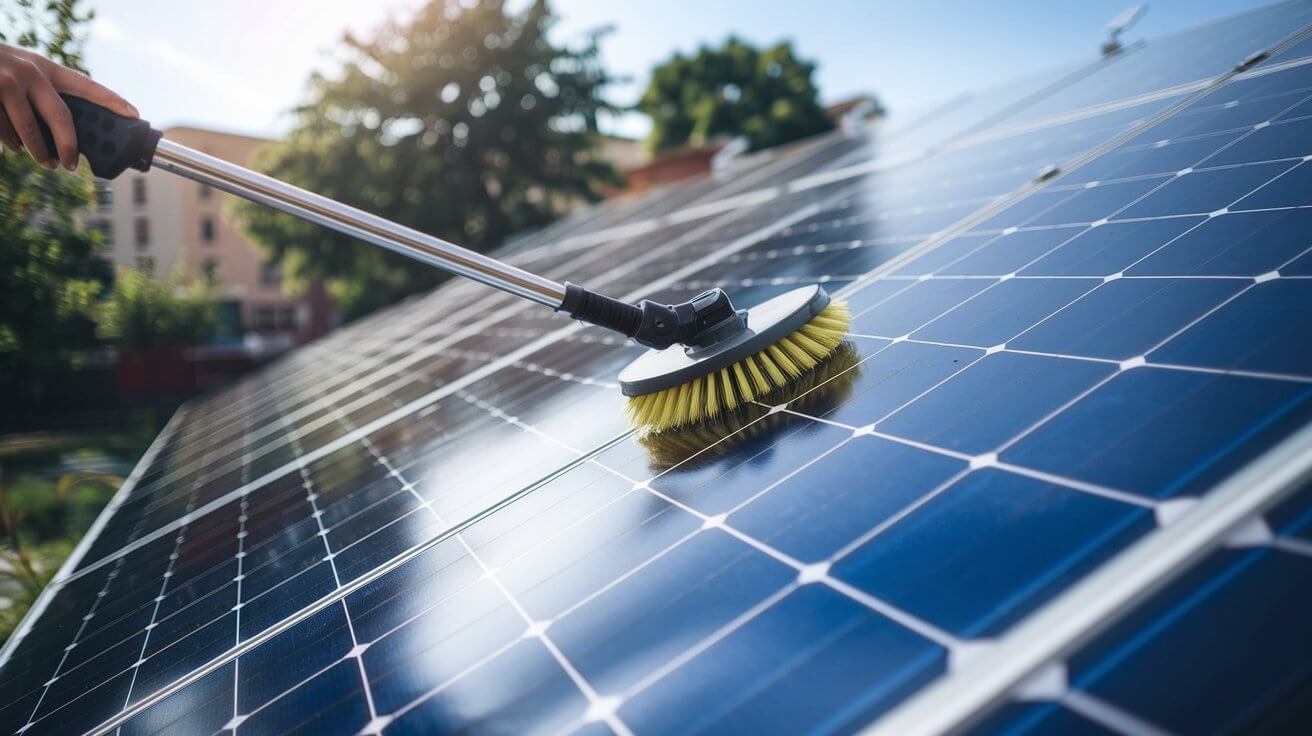A Google study at their Mountain View headquarters found that cleaning solar panels after 15 months of neglect doubled their energy output. Yet most solar owners I’ve talked to say they’ve never cleaned their panels even once! The truth about solar panel cleaning lies somewhere between these extremes, and it varies dramatically depending on where you live and what’s collecting on your panels.
Is Cleaning Your Solar Panels Actually Worth Your Time?
The honest answer? It depends. But not in that wishy-washy way experts usually dodge the question.
Real-world solar owners report wildly different experiences with solar panel cleaning. A California Redditor shared that a simple weekend cleaning session yielded an extra 10kWh per day—a substantial boost to their system’s performance! Meanwhile, an Arizona system owner reported that even after 124 days without rain, their dirty panels still produced about 95% of their maximum capacity.
Here’s the reality: solar panel cleaning matters most when:
- You live in a region with long dry spells
- Your panels are mounted at a minimal tilt (less than 5 degrees)
- You’re near pollution sources like highways, construction, or agricultural areas
- Trees overhang your array, attracting birds and dropping sap
- You’ve noticed actual visible buildup (not just a light dusting)
For most people, the 5-10% production improvement from cleaning won’t justify paying $150-300 for professional services. That’s simple math. But DIY solar panel cleaning? That’s where the real value lies.
The Truth About Rain: Nature’s Free Cleaning Service?
“Just let the rain clean them!” This advice pops up in every forum. But does it work?
Not entirely. Rain helps, but it’s not perfect. Research shows that panels mounted at a tilt of at least 5 degrees will get reasonably clean from rainfall, but even then, certain substances resist rain’s washing effect:
- Bird droppings (they bake on in the sun!)
- Tree sap (it’s sticky and holds other debris)
- Pollen (especially during heavy pollen seasons)
- Industrial fallout and highway pollution
- Lichen and algae growth in humid climates
A UK solar owner in the r/solar subreddit discovered this firsthand during pollen season, noting performance drops of 100W on their 400W panels until manually cleaned. Rain simply couldn’t handle the sticky pollen residue.
Regional Solar Panel Cleaning Strategies That Actually Work
The biggest mistake in most cleaning guides? Treating all solar installations the same. Your location drastically affects your solar panel cleaning needs.
Desert Dwellers (Southwest US, Australia)
If you’re in Phoenix or similar areas, dust accumulation is your enemy. Actual forum users in these regions suggest:
- Clean before summer to maximize peak production season
- Focus on the bottom edge where dust collects
- Consider a long-handled soft brush with a hose attachment
- Clean during early morning when dew makes dirt easier to remove
Coastal Locations
Marine layer residue and salt spray create unique challenges. Users from coastal regions recommend:
- More frequent cleaning (3-4 times yearly)
- Using fresh water to prevent mineral buildup
- Squeegee drying to prevent spotting
- Specialized solutions that cut through salt deposits
Seasonal Challenge Areas
For those in regions with distinct seasons like the Northeast, forum users recommend:
- Post-pollen season cleanup (usually late spring)
- Post-wildfire cleaning if ash has settled
- Fall cleaning before winter to remove leaf debris
- Snow removal techniques during winter months
Reddit’s Favorite: The “Simulated Rainfall” Technique
One cleaning method consistently earns praise on forums for its simplicity and effectiveness. One user called BentPin described it perfectly: “I like to arc the water coming out of my garden hose to simulate rainfall. It gets the jobs done.”
This gentle approach sends water cascading down panels much like natural rain but with better timing and targeting. It works especially well for routine dust and light dirt. Best of all, you can do it from the ground without climbing dangerous ladders!
To try it yourself:
- Use a standard garden hose with an adjustable nozzle
- Position yourself where you can see the panels
- Adjust to a gentle shower setting (not jet or pressure wash!)
- Arc the water so it falls naturally onto panels
- Start at the top and work your way down
- Let panels air dry naturally
This method won’t tackle baked-on bird droppings or stubborn residue, but for routine maintenance, it’s ideal.
The Morning Dew Secret Weapon
Another brilliant tip from real solar owners: use morning dew to your advantage! Multiple forum users suggested cleaning panels while morning dew is still present.
The moisture softens dirt and dust, making it easier to remove without excessive scrubbing. This technique conserves water and reduces the risk of mineral deposits from hard water. One Michigan solar owner reported a 15% performance improvement using this method during pollen season.
Early morning also means cooler panels—important since cleaning hot panels can cause thermal shock if cold water is applied suddenly.
Dealing With The Tough Stuff: Bird Droppings, Tree Sap, and Lichen
Regular dust is one thing, but what about the stubborn contaminants rain can’t handle? Here’s what actual panel owners recommend:
Bird Droppings
These can genuinely impact performance by creating “hot spots” on panels. Forum users suggest:
- Soften with water and a bit of mild soap
- Use a soft sponge on an extension pole
- Never scrape with anything hard or abrasive
- Work during cooler morning hours
Tree Sap and Pollen
The sticky nemesis of many solar arrays! Real-world solutions include:
- Diluted white vinegar solution (1:10 with water)
- Longer soaking time before gentle wiping
- More frequent cleaning during heavy pollen seasons
- Pruning overhanging branches where possible
Lichen and Algae Growth
In humid climates, biological growth can become an issue. Solar owners report success with:
- Biodegradable soap solutions
- Soft brush cleaning with extension poles
- More frequent cleaning to prevent establishment
- Ensuring proper panel ventilation
The Hard Water Problem Nobody Talks About
One issue rarely addressed in professional guides but frequently mentioned in forums? Hard water spots.
Cleaning with mineral-rich tap water can leave residue that actually decreases panel efficiency! Forum users have developed several solutions:
- Add a small amount of vinegar to your cleaning water
- Use distilled water for final rinsing
- Squeegee panels dry after cleaning
- Collect rainwater for cleaning purposes
- Consider inexpensive water deionizers for panel cleaning
A DIY Solar Forum user from California explained how switching to distilled water for final rinsing improved his results dramatically. Those water spots aren’t just cosmetic—they create tiny shadows that reduce production!
Safety First: Is Cleaning Even Worth The Risk?
The most profound insight from real solar owners might surprise you: many choose not to clean their panels at all due to safety concerns.
“I’m going to pass climbing on my two-story house roof,” wrote one forum user, echoing a common sentiment. Others mentioned waiting for rain rather than risking injury. In fact, the general consensus among forum users was that a 5-10% performance improvement simply doesn’t justify roof-climbing risks.
If you’re considering cleaning your solar panels, always:
- Stay on the ground if possible
- Use extension tools rather than ladders
- Clean during cool, dry weather with no wind
- Never walk on panels themselves
- Have someone else present while working
The Final Verdict: My Practical Solar Panel Cleaning Recommendation
After analyzing countless forum discussions and real-user experiences, here’s my practical take on solar panel cleaning:
- If you have ground-mounted panels, clean them yourself 1-2 times yearly using gentle methods
- If you have roof-mounted panels with a good tilt, let rain handle most cleaning
- Use the “simulated rainfall” technique from the ground for occasional touch-ups
- Only address stubborn spots if there’s visible buildup affecting performance
- Never risk safety for minimal efficiency gains
- Track your system’s performance before and after cleaning to determine if it’s worthwhile for YOUR specific situation
Remember, solar panel cleaning isn’t one-size-fits-all. Your location, installation type, surrounding environment, and comfort with maintenance all play crucial roles in deciding the right approach. Listen to real experiences, not just manufacturer recommendations!
What works for your solar panels? Have you tried cleaning them yourself or hired professionals? Share your experiences in the comments!

